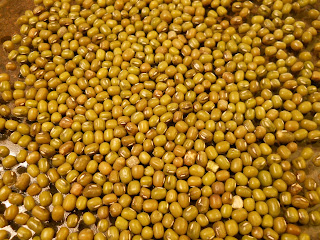Cornbread is an American classic, usually found in the southern United States. It is classified as a quick bread, which basically means it uses leavening agents other than yeast.
For some reason, I have always found it rather difficult to make. Until now. I figured out this recipe through researching other recipes and doing some experimentation in the kitchen. I was actually able to make it completely gluten and dairy-free. To my surprise, I like it better than other versions I have tried!
To make it, combine the following dry ingredients in a mixing bowl:
- 1 cup yellow cornmeal
- 1/2 cup chickpea flour
- 1/2 cup white rice flour
- 1/4 cup sugar
- 2 teaspoons baking powder
- 1 teaspoon baking soda
- 1/2 teaspoon salt
(You may want to use a whisk to combine the ingredients thoroughly.)
In a separate bowl, combine the following wet ingredients:
- 1 egg
- 1/4 cup olive oil
- 1 cup rice milk
I decided to use rice milk in this recipe, because of its sweetness. (To view how to make your own rice milk, click here.)
Next, combine the dry and wet ingredients together. Mix thoroughly using a whisk to prevent any lumps from being formed.
Transfer the batter into a greased 8" baking pan. Place it in a pre-heated 375°F oven for approximately 25 minutes.
As the cooking time will depend on your individual oven, check the loaf using a toothpick to make sure it is done. Basically, insert a toothpick into the loaf and remove it. If the toothpick comes out clean, your bread is done.
Your cornbread should have and even golden colour, as seen below.
This particular cornbread is light and fluffy. It is extremely easy to cut and has complex savory and sweet qualities. Not to mention, it smells divine!
For some reason, I have always found it rather difficult to make. Until now. I figured out this recipe through researching other recipes and doing some experimentation in the kitchen. I was actually able to make it completely gluten and dairy-free. To my surprise, I like it better than other versions I have tried!
To make it, combine the following dry ingredients in a mixing bowl:
- 1 cup yellow cornmeal
- 1/2 cup chickpea flour
- 1/2 cup white rice flour
- 1/4 cup sugar
- 2 teaspoons baking powder
- 1 teaspoon baking soda
- 1/2 teaspoon salt
(You may want to use a whisk to combine the ingredients thoroughly.)
In a separate bowl, combine the following wet ingredients:
- 1 egg
- 1/4 cup olive oil
- 1 cup rice milk
I decided to use rice milk in this recipe, because of its sweetness. (To view how to make your own rice milk, click here.)
Next, combine the dry and wet ingredients together. Mix thoroughly using a whisk to prevent any lumps from being formed.
Transfer the batter into a greased 8" baking pan. Place it in a pre-heated 375°F oven for approximately 25 minutes.
As the cooking time will depend on your individual oven, check the loaf using a toothpick to make sure it is done. Basically, insert a toothpick into the loaf and remove it. If the toothpick comes out clean, your bread is done.
Your cornbread should have and even golden colour, as seen below.
This particular cornbread is light and fluffy. It is extremely easy to cut and has complex savory and sweet qualities. Not to mention, it smells divine!























































